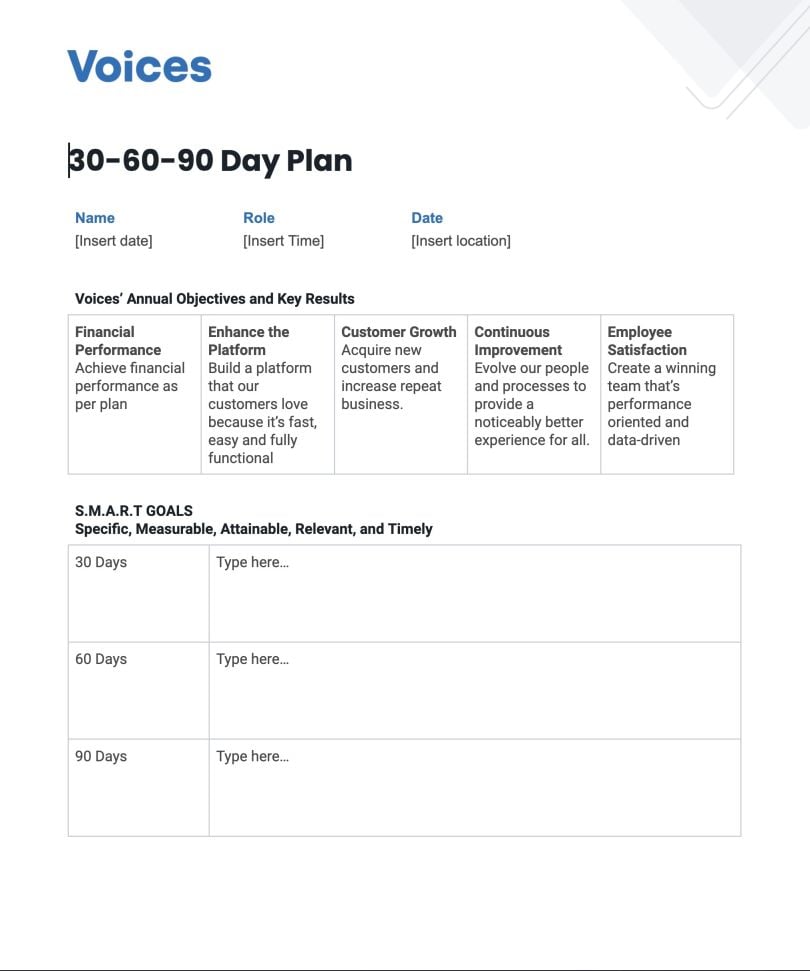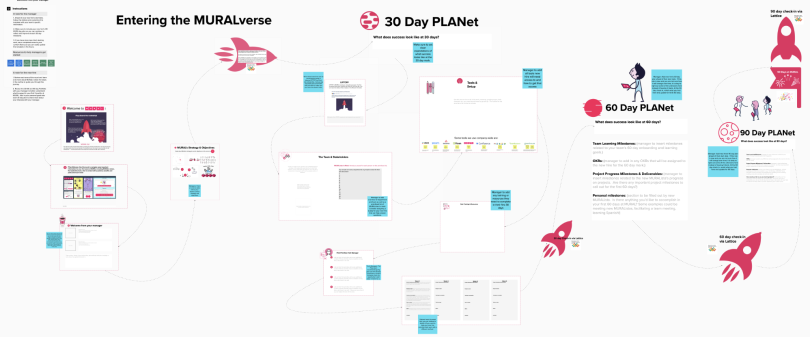A 30-60-90 day plan is essential for onboarding effectively at any company, as it help outlines expectations for an employee to meet when entering a new job.
30-60-90 Day Plan Definition
A 30-60-90 day plan is a document that guides an employee on the expectations and goals they should be striving for during the first 30, 60 and 90 days on the job.
Whether you’re starting a new job, or you’re a manager bringing a new employee onboard, we’ve compiled a comprehensive set of tips to create 30-60-90 day plans that will support successful onboarding.
What Is a 30-60-90 Day Plan?
A 30-60-90 day plan is a document that guides an employee on the expectations and goals they should meet during the first 30, 60 and 90 days on the job. Typically provided for new employees on or before their first day of work, they are a common component of companies’ onboarding processes, as they’re used to set up a new employee for success right away.
The plan “needs to be some kind of structure that you mutually agree on, a structure that is outcome-focused and that helps people go towards maximizing their contribution to your company as fast as possible,” Rik Haandrikman, vice president of growth at Bitrise, told Built In. “Without a plan, it’s a mess, and 30-60-90 days works.”
At Bitrise, 30-60-90 day plans tend to be pretty high level, with a few bullet points for each milestone. The first 30 days are all about understanding the context of the business. At the 60 days, employees should be proposing concrete steps to reach an outcome, and by day 90, the company wants to start seeing deliverables.
30-60-90 day plans can also be shaped by both a manager and the employee to fit mutual needs. This is where a manager provides overall support and makes sure company-wide tasks and department-specific KPIs are covered, but leaves enough room for the employee to set their own goals too.
These plans can be so flexible that some companies, like Instawork, even use a 14-30-60 day plan. “It’s really important to get things going quickly,” said Sumir Meghani, co-founder and CEO of Instawork.
Adriana Roche, chief people officer at Mural, suggests managers have a 30-60-90 day plan ready for a new employee but to sit down with them to discuss and modify the plan as needed.
“The important thing is that you fill this out before the person starts. So on day one, you sit down with them, and you walk them through this journey,” Roche said. “The person feels like they’ve co-created their onboarding versus just having something handed to them.”
Benefits of a 30-60-90 Day Plan
Makes Employee Onboarding Structured and Approachable
30-60-90 day plans are a digestible way to help an employee transition into their role smoothly, have a vision for their position and not feel too overwhelmed.
“We’re just trying to distill [work] down to something that’s achievable in the foreseeable future. Most people can get their heads around three months,’” David Ciccarelli, CEO of Voices, told Built In.
Boosts Employee Confidence and Sense of Belonging
These plans can give employees a consistent introduction to the company and help them feel confident about joining.
“If you do it well, you create a sense of cohesion with the people, so creating a sense of belonging, and then getting people ramped up as quickly as possible.” Roche said. “They’re going to feel much more engaged because they’re feeling like they’re having an impact from the get-go.”
Useful for Transitions Into New Roles or After Leaves
30-60-90 plans don’t have to be just for new employees, Ciccarelli said. You can use them to help someone transition into a new role or acclimate again after a leave.
“Any kind of re-entry, the 30-60-90 day plan is a great level set,” Ciccarelli noted. “In consideration of a promotion, that actually is much more meaningful because somebody has the context of what are the big objectives of the year.”
To make a 30-60-90 day plan, it’s helpful to know common goals associated with each major milestone. Here’s what you can expect to accomplish or see from employees 30, 60 and 90 days into a new job.
30 Days Into a 30-60-90 Day Plan
Complete Common Onboarding Tasks
The first 30 days in a new job should be all about creating a foundation of knowledge before diving in head first. These types of tasks can include:
- Reading company handbooks and guides.
- Learning company culture and history.
- Learning company processes around benefits, requesting time off, etc.
- Gaining access to and learning how to use tools and systems (email, chat, software tools).
- Attending coffee chats or onboarding sessions offered by your company.
Meet Managers, Team Members and Collaborators
At many companies, part of onboarding can look like having 15- to 30-minute one-on-one meetings with team members or collaborators. It’s especially important to meet with your manager on the first or second day of a new job to discuss what their expectations are.
“The list of people your manager is getting you to talk to, those are your performance review people,” said Alexandria “Lexi B.” Butler, who has worked in tech for several years and is the founder of Sista Circle: Black Women in Tech. “Literally your manager is telling you, these are the people that I will talk to to see if you get a raise.”
New hires will want to ask their coworkers about what they do, how their jobs impact one another and their overall thoughts on company culture and processes.
Some companies have a buddy system for new employees, where they can get to know someone else at the company who they can go to for guidance that isn’t their direct manager.
“We make sure that we also have a peer onboarding partner, so really having a buddy with somebody, a safe space where you can ask those questions that you perhaps wouldn’t want to ask of your manager,” Rebecca Port, chief people officer at 10x Genomics, told Built In. “Someone who can help you understand the context of the why behind things.”
Go Over Responsibilities and Company Dynamics
During these first 30 days, take time to go over the responsibilities in the job description and start to think of a plan to tackle them, plus focusing on learning the company dynamics, according to Annabel Maw, director of communications at Jotform.
“It’s mostly just getting a really good framework and foundation for how the company operates and how the product works, and then just understanding the competitive landscape too in the industry,” Maw said.
60 Days Into a 30-60-90 Day Plan
Have Steps to Reach a Goal and Start to Contribute
Before the first 60 days, many companies expect that there will be outlined steps for meeting an employee’s initial goals or completing first projects.
By day 60, Ciccarelli said Voices employees are expected to have an understanding of the product and be able to give a product demonstration, which is a rite of passage for new employees. At Bitise, Haandrikman said employees should strive to start making an impact on the business after the first 30 days by outlining specific steps to reach a goal.
Deepen Colleague Relationships and Discuss Projects
Conversations with colleagues should continue after the first 30 days, Butler said, and these conversations should go even deeper to help employees learn about how they are performing against expectations so far.
90 Days Into a 30-60-90 Day Plan
Have an Outcome to Share and Make Suggestions
By the end of an employee’s first 90 days, they are often expected to have an outcome to share with the company, such as completing a key first assignment or goal. It’s also not too early to start making enhancements at the company by day 90, Haandrikman said.
Reflect and Review With Your Manager
At an employee’s 90-day review with their manager, Butler suggests asking these questions:
- What have I done well?
- What can I work on?
- How do you see me in this role evolving in the next year?
These questions will help you to understand your strengths and where you stand out — your special skills and abilities that will help shape your career.
“Now people have gotten to know you. They’ve gotten to see your strengths and your weaknesses because everybody has them,” Butler said. “You start creating your career … people just start seeing it, and in those 90 days, people will start giving you those tidbits.”
30-60-90 Day Plan Templates
While 30-60-90 day plans can be highly personalized to the employee, a template is a proven way to help a manager get started and make sure they don’t forget all of the essential tasks needed for onboarding.
These 30-60-90 day template ideas — whether provided by a company or used for personal progress tracking — can be used to outline and track expectations for new employees.
Simple 30-60-90 Day Plan Template

Voices’ 30-60-90 day plan template, as shared by Ciccarelli, fits on one page and is in bullet form. This type of template is effective for making plan notes in a simple format that can be fleshed out later. It also implements a SMART goal template, which gives employees direction for writing clear goals.
Visual 30-60-90 Day Plan Template

As for Mural’s 30-60-90 day plan template, this example is highly visual and maps out a path for an employee to follow over the course of the first three months. Templates like this can keep the 30-60-90 day plan fun and light-hearted, and provide images alongside goals to help employees better visualize what they should accomplish.
Create Your Own 30-60-90 Day Plan Template
It also doesn’t have to be all up to the company to provide a plan to follow.
For Butler when she enters a new job, she creates an Excel document with tabs for 30, 60 and 90 days. She has columns for the tasks she’s working on and the feedback she receives. For items she’s told to keep working on after the first 30 days, she copies them to the 60 day tab, and so on.
She also said working with software tools like Workday has been a helpful way to keep both the employee and manager accountable with documenting progress.
In many cases, how well an employee follows a 30-60-90 plan can be a strong predictor of their future success at the company.
Frequently Asked Questions
What is a 30-60-90 day plan?
A 30-60-90 day plan is a document that outlines expectations or goals new employees should meet within their first 30, 60 and 90 days at a company.
What should be included in a 30-60-90 day plan?
A 30-60-90 plan should include:
- Defined goals or expectations a new employee should meet by day 30, 60 and 90
- Information about onboarding, training and key employee documents or systems to access
- Information about who to contact or what other resources to reference to help reach the defined goals




